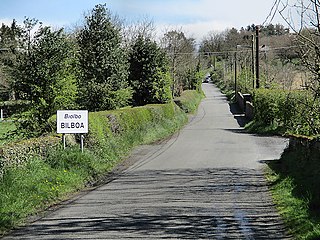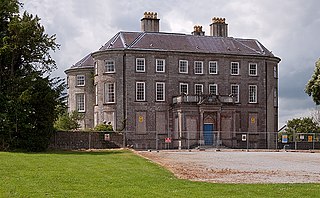
Castlepollard is a village in north County Westmeath, Republic of Ireland. It lies west of Lough Lene and northeast of Lough Derravaragh and Mullingar.
Sir Edward Lovett Pearce was an Irish architect, and the chief exponent of Palladianism in Ireland. He is thought to have initially studied as an architect under his father's first cousin, Sir John Vanbrugh. He is best known for the Irish Houses of Parliament in Dublin, and his work on Castletown House. The architectural concepts he employed on both civic and private buildings were to change the face of architecture in Ireland. He could be described as the father of Irish Palladian architecture and Georgian Dublin.
The architecture of Ireland is one of the most visible features in the Irish countryside – with remains from all eras since the Stone Age abounding. Ireland is famous for its ruined and intact Norman and Anglo-Irish castles, small whitewashed thatched cottages and Georgian urban buildings. What are unaccountably somewhat less famous are the still complete Palladian and Rococo country houses which can be favourably compared to anything similar in northern Europe, and the country's many Gothic and neo-Gothic cathedrals and buildings.

Bilboa is a settlement located on the boundaries of counties Carlow, Laois and Kilkenny in Ireland. A bridge, a short distance from the village and built c. 1800, is known as the 'Three Counties Bridge'.

Street or Streete is a village and parish in County Westmeath, Ireland. It lies on the regional road between Lismacaffery and Rathowen. Its Irish name was historically anglicised as Straid or Strade.

Mount Loftus is a country estate in the civil parish of Powerstown in County Kilkenny, Ireland. It was originally home to the Loftus baronets, the baronetcy being extinct since the death of the third baronet in 1864. The original 18th century manor house was demolished in 1906. The current house on the estate, built in the early 20th century, was rebuilt from staff accommodations after a fire in the 1930s. This house, and several of its outbuildings, are included on Kilkenny County Council's Record of Protected Structures.
Cloughjordan House is a private residence in Cloughjordan, County Tipperary, Ireland. Built on the site of a tower house that was extended in the 17th and 18th centuries. The present house comprises a central two storey five bay section flanked by two gable fronted sections.
Slevoir is a townland in the Barony of Ormond Lower, County Tipperary, Ireland. It is located in the civil parish of Terryglass overlooking Slevoir Bay, the most north-eastern part of Lough Derg
George Morgan Magan, Baron Magan of Castletown, is a Conservative member of the House of Lords of the United Kingdom. He comes from an Anglo-Irish family, and is the son of the late Brigadier Bill Magan, who served as a director at MI5. He was educated at Winchester College and then became a Chartered Accountant.
Clonahenoge is a townland in County Offaly, Ireland. It is located at the confluence of the Little Brosna River and the River Shannon.
Sopwell is a townland in the historical Barony of Ormond Lower, County Tipperary, Ireland.
Sharavogue is a townland in the historical Barony of Clonlisk, County Offaly, Ireland. It is a rural area located near the junction of the N52 road and the R492 between Roscrea and Birr. The Little Brosna River flows under Sharavogue bridge.
Charles Augustus Vignoles was a Nineteenth century Church of Ireland dean, specifically the dean of Ossory and the dean of the Chapel Royal, Dublin.
Michael Cox was an Anglican archbishop in Ireland during the 18th century. He is now chiefly remembered for building one of Ireland's most magnificent remaining mansions, Castletown Cox, near Carrick-on-Suir. A younger son of Sir Richard Cox, 1st Baronet, Lord Chancellor of Ireland from 1703 to 1707, and his wife Mary Bourne, he was born in Cork. He was educated at Kilkenny College and Christ Church, Oxford and ordained in 1713. He became Chaplain to Charles Butler, 1st Earl of Arran, then Rector of Calan and Chancellor of Kilkenny. In 1743 he became Bishop of Ossory; and in 1754, Archbishop of Cashel. In 1755 he was made a member of the Privy Council of Ireland.
Southwell Gift Houses are 17th-century almshouses in Kinsale. They are four houses for the pensioners and a supervisors house within a compound overlooking the town.
Ashleypark is a townland in the historical Barony of Ormond Upper, County Tipperary, Ireland.

Doneraile Court is a late-17th century country house near the town of Doneraile in County Cork, Ireland. It stands in 160 hectares of walled parkland known as Doneraile Park or Doneraile Estate. The house remained the seat of the St Leger family from the time of construction until the mid-20th century. The park, which is managed by the Office of Public Works (OPW), is open all year with free admission. As of 2023, Donerail Park was the most visited free tourist attraction in County Cork, and the fifth most visited OPW site in the country.

Kyteler's Inn is a public house located in the centre of medieval Kilkenny in Ireland.






